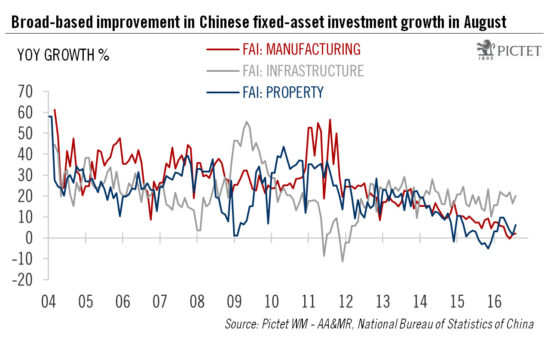Growth momentum regained traction in August after a poor July. Although GDP figures for the third quarter may surprise on the upside, the longer-term trend still shows Chinese growth slowing. Major economic indicators for August point to broad-based stabilisation of China's growth momentum after a weak start to the second half. The more upbeat macro picture is supported by improvements in the PMI reading and import data, and leads us to believe the likelihood of an upside surprise for China's Q3 GDP growth is rising.Growth in fixed asset investment rebounded in August, reaching its highest level since April 2016, thanks to post-flood reconstruction, stronger property investment and support for infrastructure. The government has been actively using fiscal measures to support infrastructure investment and, in particular, to push for more rapid implementation of approved projects.Industrial production also improved year-on-year in August. Mining benefited from a rebound in commodity prices and there was a mild recovery in global demand for Chinese exports. China’s industrial exports rose by 2.9% year-over-year in August, compared with 1.3% growth in July. Household consumption has also proved resilient. Retail sales in August rose at a year-on-year rate of over 10%, with particularly strong growth seen in e-commerce and auto sales.
Topics:
Dong Chen considers the following as important: Chinese fixed asset investment, Chinese growth, Chinese industrial production, Chinese property, Macroview
This could be interesting, too:
Cesar Perez Ruiz writes Weekly View – Big Splits
Cesar Perez Ruiz writes Weekly View – Central Bank Halloween
Cesar Perez Ruiz writes Weekly View – Widening bottlenecks
Cesar Perez Ruiz writes Weekly View – Debt ceiling deadline postponed
Growth momentum regained traction in August after a poor July. Although GDP figures for the third quarter may surprise on the upside, the longer-term trend still shows Chinese growth slowing.

Major economic indicators for August point to broad-based stabilisation of China's growth momentum after a weak start to the second half. The more upbeat macro picture is supported by improvements in the PMI reading and import data, and leads us to believe the likelihood of an upside surprise for China's Q3 GDP growth is rising.
Growth in fixed asset investment rebounded in August, reaching its highest level since April 2016, thanks to post-flood reconstruction, stronger property investment and support for infrastructure. The government has been actively using fiscal measures to support infrastructure investment and, in particular, to push for more rapid implementation of approved projects.
Industrial production also improved year-on-year in August. Mining benefited from a rebound in commodity prices and there was a mild recovery in global demand for Chinese exports. China’s industrial exports rose by 2.9% year-over-year in August, compared with 1.3% growth in July. Household consumption has also proved resilient. Retail sales in August rose at a year-on-year rate of over 10%, with particularly strong growth seen in e-commerce and auto sales.
Signs of an improvement in the macro picture hopefully will provide the government with a precious window of opportunity to correct some structural problems in the economy. In the near term, that means cutting overcapacity in heavy industries like steel making and coal mining. In the medium to long term, it means deleveraging of the non-financial corporate sector should also be on the agenda.
At the same time, while the improved macro picture alleviates near-term concerns, the Chinese economy is still facing a structural downward trend in growth. For the moment, we maintain our forecast of 6.5% for China's GDP growth for 2016 and we expect growth to decline to 6.2% in 2017.
